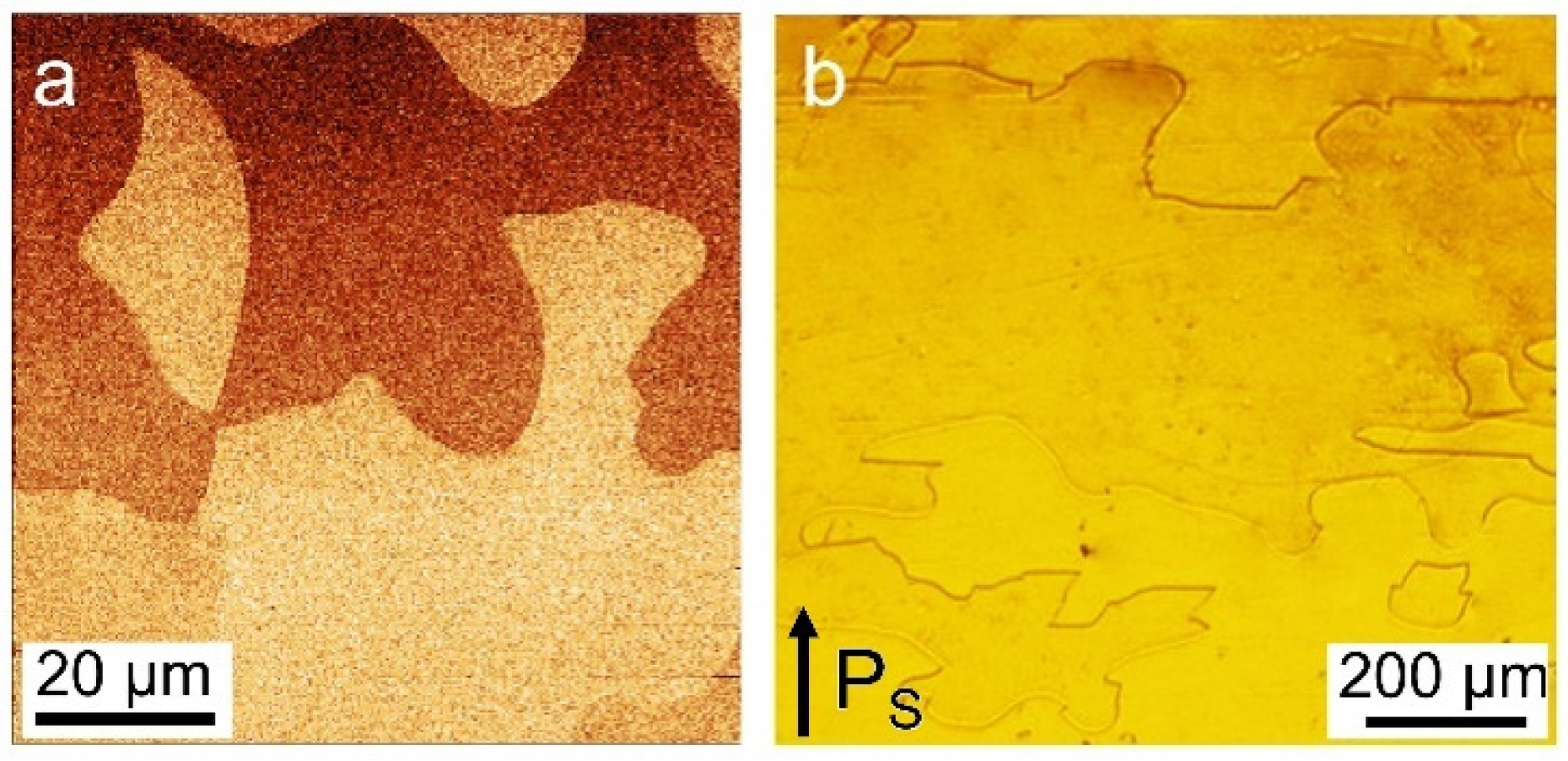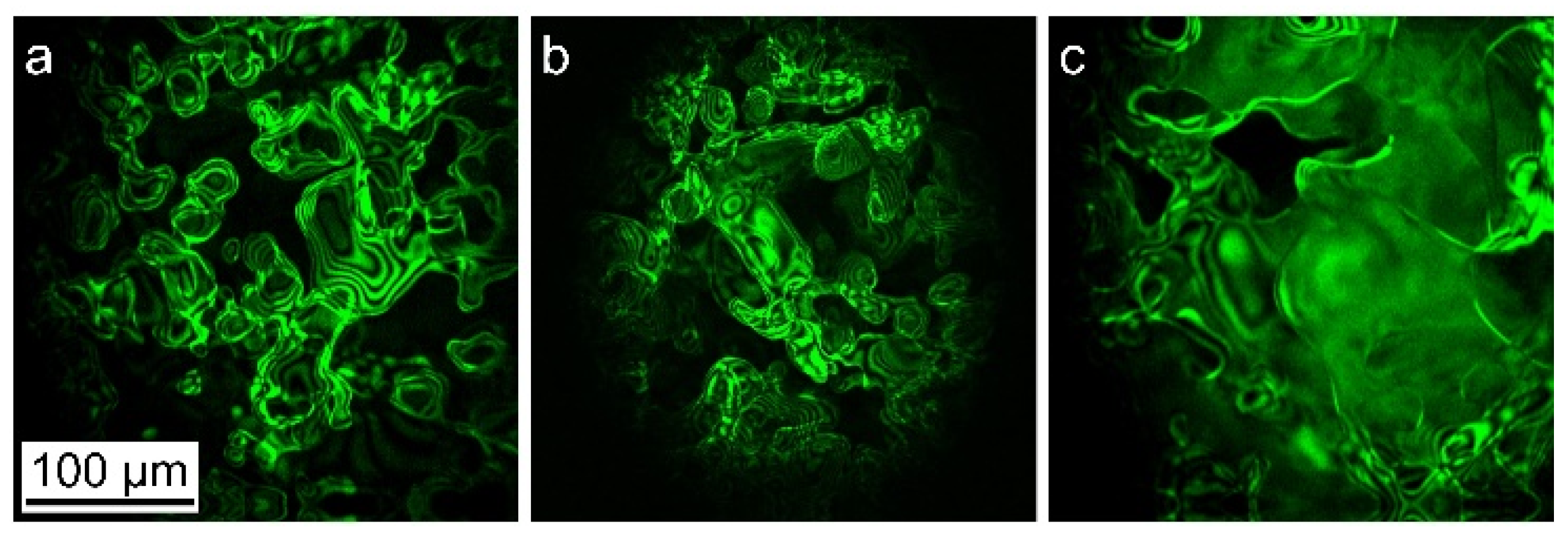Field-Induced Evolution of As-Grown Domain Structure in Annealed Calcium Orthovanadate Crystal
Abstract
:1. Introduction
2. Materials and Methods
3. Results
3.1. Initial Domain Structure
3.2. Switching in the Uniform Field
4. Discussion
5. Conclusions
Author Contributions
Funding
Data Availability Statement
Acknowledgments
Conflicts of Interest
References
- Brixner, L.H.; Flournoy, P.A. Calcium orthovanadate Ca3(VO4)2-a new laser host crystal. J. Electrochem. Soc. 1965, 112, 303–308. [Google Scholar] [CrossRef]
- Glass, A.M.; Abrahams, S.C.; Ballman, A.A.; Loiacono, G. Calcium orthovanadate, Ca3(VO4)2-a new high-temperature ferroelectric. Ferroelectrics 1977, 17, 579–582. [Google Scholar] [CrossRef]
- Bechthold, P.S.; Liebertz, J.; Deserno, U. Linear and nonlinear optical properties of Ca3(VO4)2. Opt. Commun. 1978, 27, 393–398. [Google Scholar] [CrossRef]
- Ivleva, L.I.; Dunaeva, E.E.; Voronina, I.S.; Doroshenko, M.E.; Papashvili, A.G. Ca3(VO4)2:Tm3+—A new crystalline medium for 2-μm lasers. J. Cryst. Growth 2018, 501, 18–21. [Google Scholar] [CrossRef]
- Hum, D.S.; Fejer, M.M. Quasi-phasematching. Comptes Rendus Phys. 2007, 8, 180–198. [Google Scholar] [CrossRef]
- Fejer, M.M.; Jundt, D.H.; Byer, R.L.; Magel, G.A. Quasi-phase-matched second harmonic generation: Tuning and tolerances. IEEE J. Quantum Electron. 1992, 28, 2631–2654. [Google Scholar] [CrossRef]
- Byer, R.L. Quasi-phasematched nonlinear interactions and devices. J. Nonlinear Opt. Phys. Mater. 1997, 6, 549–592. [Google Scholar] [CrossRef]
- Shishkina, E.V.; Greshnyakov, E.D.; Zelenovskiy, P.S.; Yuzhakov, V.V.; Ivleva, L.I.; Shur, V.Y. Micro-Raman domain imaging in calcium orthovanadate single crystals. Ferroelectrics 2021, 576, 85–93. [Google Scholar] [CrossRef]
- Shishkina, E.; Yuzhakov, V.; Nebogatikov, M.; Pelegova, E.; Linker, E.; Ivleva, L.; Shur, V. As-grown domain structure in calcium orthovanadate crystals. Crystals 2021, 11, 1508. [Google Scholar] [CrossRef]
- Sheng, Y.; Best, A.; Butt, H.J.; Krolikowski, W.; Arie, A.; Koynov, K. Three-dimensional ferroelectric domain visualization by Čerenkov-type second harmonic generation. Opt. Express 2010, 18, 16539–16545. [Google Scholar] [CrossRef]
- Shishkina, E.V.; Chuvakova, M.A.; Yuzhakov, V.V.; Akhmatkhanov, A.R.; Pelegova, E.V.; Nebogatikov, M.S.; Ushakov, A.D.; Linker, E.A.; Ivleva, L.I.; Shur, V.Y. Domain structure evolution during polarization reversal in calcium orthovanadate single crystals. J. Appl. Phys. 2022, 132, 184101. [Google Scholar]
- Yuzhakov, V.V.; Chuvakova, M.A.; Shishkina, E.V.; Nebogatikov, M.S.; Linker, E.A.; Akhmatkhanov, A.R.; Pelegova, E.V.; Ivleva, L.I.; Shur, V.Y. Kinetics of the domain structure in calcium orthovanadate crystals under application of the series of electric field pulses. Ferroelectrics 2024, 618, 1339–1345. [Google Scholar]
- Doshi, S.P.; West, G.N.; Gray, D.; Ram, R.J. Thermal enhancement of defect motion for optimizing periodic poling of X-cut thin-film lithium niobate. Appl. Phys. Lett. 2024, 125, 261103. [Google Scholar]
- Gopalan, V.; Gupta, M.C. Observation of internal field in LiTaO3 single crystals: Its origin and time-temperature dependence. Appl. Phys. Lett. 1996, 68, 888–890. [Google Scholar]
- Holman, R.L.; Cressman, P.J.; Revelli, J.F. Chemical control of optical damage in lithium niobate. Appl. Phys. Lett. 1978, 32, 280–283. [Google Scholar] [CrossRef]
- Gonzalez, M.; Margueron, S.; Murauskas, T.; Boulet, P.; Gauthier-Manuel, L.; Dulmet, B.; Bartasyte, A. Influence of parameters in vapor transport equilibration treatment on composition and homogeneity of LiTaO3 single crystals. Phys. Status Solidi 2025, 222, 2400129. [Google Scholar]
- Bordui, P.F.; Norwood, R.G.; Jundt, D.H.; Fejer, M.M. Preparation and characterization of off-congruent lithium niobate crystals. J. Appl. Phys. 1992, 71, 875–879. [Google Scholar]
- Kämpfe, T.; Reichenbach, P.; Haußmann, A.; Woike, T.; Soergel, E.; Eng, L.M. Real-time three-dimensional profiling of ferroelectric domain walls. Appl. Phys. Lett. 2015, 107, 152905. [Google Scholar]
- Gureev, M.Y.; Mokrý, P.; Tagantsev, A.K.; Setter, N. Ferroelectric charged domain walls in an applied electric field. Phys. Rev. B Condens. Matter Mater. Phys. 2012, 86, 104104. [Google Scholar]
- Gureev, M.Y.; Tagantsev, A.K.; Setter, N. Head-to-head and tail-to-tail 180° domain walls in an isolated ferroelectric. Phys. Rev. B 2011, 83, 184104. [Google Scholar]
- Tagantsev, A.K.; Cross, L.E.; Fousek, J. Domains in Ferroic Crystals and Thin Films; Springer: New York, NY, USA, 2010. [Google Scholar]
- Morozovska, A.N.; Eliseev, E.A.; Svechnikov, G.S.; Kalinin, S.V. Mesoscopic mechanism of the domain wall interaction with elastic defects in uniaxial ferroelectrics. J. Appl. Phys. 2013, 113, 187203. [Google Scholar]
- Gopalan, V.; Dierolf, V.; Scrymgeour, D.A. Defect-domain wall interactions in trigonal ferroelectrics. Annu. Rev. Mater. Res. 2007, 37, 449–489. [Google Scholar]
- Yang, T.J.; Gopalan, V.; Swart, P.J.; Mohideen, U. Direct observation of pinning and bowing of a single ferroelectric domain wall. Phys. Rev. Lett. 1999, 82, 4106–4109. [Google Scholar]
- Robels, U.; Arlt, G. Domain wall clamping in ferroelectrics by orientation of defects. J. Appl. Phys. 1993, 73, 3454–3460. [Google Scholar]
- Shur, V.Y.; Pelegova, E.V.; Turygin, A.P.; Kosobokov, M.S.; Alikin, Y.M. Forward growth of ferroelectric domains with charged domain walls. local switching on non-polar cuts. J. Appl. Phys. 2021, 129, 044103. [Google Scholar]
- Greshnyakov, E.; Chuvakova, M.; Ushakov, A.; Akhmatkhanov, A.; Kosobokov, M.; Pryakhina, V.; Shur, V. In-bulk polarization reversal in lithium tantalate with single charged domain wall. J. Adv. Dielectr. 2023, 14, 2350032. [Google Scholar]
- Morozovska, A.N.; Eliseev, E.A.; Svechnikov, S.V.; Krutov, A.D.; Shur, V.Y.; Borisevich, A.Y.; Maksymovych, P.; Kalinin, S.V. Finite size and intrinsic field effect on the polar-active properties of ferroelectric-semiconductor heterostructures. Phys. Rev. B 2010, 81, 205308. [Google Scholar]









Disclaimer/Publisher’s Note: The statements, opinions and data contained in all publications are solely those of the individual author(s) and contributor(s) and not of MDPI and/or the editor(s). MDPI and/or the editor(s) disclaim responsibility for any injury to people or property resulting from any ideas, methods, instructions or products referred to in the content. |
© 2025 by the authors. Licensee MDPI, Basel, Switzerland. This article is an open access article distributed under the terms and conditions of the Creative Commons Attribution (CC BY) license (https://creativecommons.org/licenses/by/4.0/).
Share and Cite
Yuzhakov, V.; Chuvakova, M.; Turygin, A.; Shishkina, E.; Nebogatikov, M.; Linker, E.; Akhmatkhanov, A.; Kosobokov, M.; Melnikov, S.; Pelegova, E.; et al. Field-Induced Evolution of As-Grown Domain Structure in Annealed Calcium Orthovanadate Crystal. Crystals 2025, 15, 315. https://doi.org/10.3390/cryst15040315
Yuzhakov V, Chuvakova M, Turygin A, Shishkina E, Nebogatikov M, Linker E, Akhmatkhanov A, Kosobokov M, Melnikov S, Pelegova E, et al. Field-Induced Evolution of As-Grown Domain Structure in Annealed Calcium Orthovanadate Crystal. Crystals. 2025; 15(4):315. https://doi.org/10.3390/cryst15040315
Chicago/Turabian StyleYuzhakov, Vladimir, Maria Chuvakova, Anton Turygin, Ekaterina Shishkina, Maksim Nebogatikov, Eduard Linker, Andrey Akhmatkhanov, Mikhail Kosobokov, Semion Melnikov, Elena Pelegova, and et al. 2025. "Field-Induced Evolution of As-Grown Domain Structure in Annealed Calcium Orthovanadate Crystal" Crystals 15, no. 4: 315. https://doi.org/10.3390/cryst15040315
APA StyleYuzhakov, V., Chuvakova, M., Turygin, A., Shishkina, E., Nebogatikov, M., Linker, E., Akhmatkhanov, A., Kosobokov, M., Melnikov, S., Pelegova, E., Ivleva, L., & Shur, V. (2025). Field-Induced Evolution of As-Grown Domain Structure in Annealed Calcium Orthovanadate Crystal. Crystals, 15(4), 315. https://doi.org/10.3390/cryst15040315







